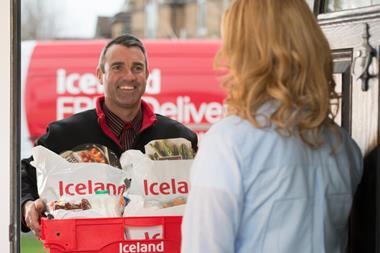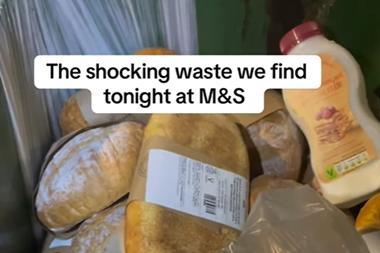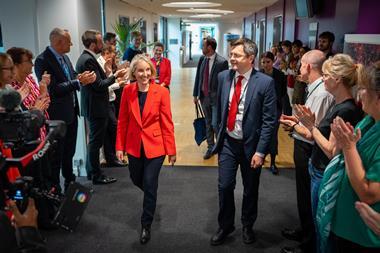Supermarkets have been ramping up click & collect and some are now looking at grocery as well as non-food… heralding the dawn of the grocery drive thru
Click & collect - it’s the hottest buzz phrase in grocery at the moment and no wonder. The service already accounts for 70% of Tesco’s online general merchandise orders Asda revealed last month that 40% of orders placed on Asda Direct and George.com were now fulfilled in store and Sainsbury’s reckons that around 50% of all of its online general merchandise purchases are now click & collect.
So rapidly has it taken off that Verdict Research estimates the ‘research online, click & collect, buy in-store’ model will account for 40% of online transactions this year alone. And not just non-food. Since 2010, Tesco has been developing a grocery click & collect service that it now offers at 45 stores - significantly not via in-store pick-up points, but drive thrus, a concept Asda is also trialling.
But what is driving this growth, how big can grocery click & collect get and will drive thrus become the collection points of choice as they already are for many click & collect services in France?
“Grocery click & collect is in 45 stores and growing fast and we are trialling joint grocery and general merchandise collection”
With all the noise surrounding click & collect, it’s easy to forget it’s still in its infancy. “Click & collect has only really been around for about three years, so everyone is still finding their feet,” attests Mark Hewitt, CEO of e-fulfilment company iForce.
The reason it’s taken off so rapidly is quite simply that consumers like it, he says. It offers convenience to those who want to be able to pick up their purchases in their own time rather than stay in the house all day waiting for a delivery to arrive and it is often cheaper or even free. The added benefit for retailers is that it overcomes the difficult ‘final mile’ associated with home deliveries and cuts down on delivery overheads.
It’s a win-win for both parties, argues Hewitt, which is why more retailers are offering the service and why volumes are picking up dramatically. In 2011, iForce reported a 38% increase in the number of deliveries to stores for customers to collect, and Hewitt says the number of click & collect orders continued to rise sharply in the year to May 2012.
Much of this recent rapid growth has been driven by the likes of Sainsbury’s, which has one of the most mature click & collect models of the multiples. It currently offers click & collect in 904 stores - around 88% of its estate, according to Jon Rudoe, Sainsbury’s director of online.
Although there are no plans at present to introduce a grocery click & collect service, with its general merchandise sales growing faster than food sales, click & collect has a key role to play in the future of Sainsbury’s online non-food business, he believes.
“We know that customers really value the convenience of the service and we anticipate that its popularity will continue to grow as more and more people look to balance the busyness of their lives with the convenience of online shopping.”
Sainsbury’s may lead the pack, but Tesco isn’t far behind. Currently available in 770 Tesco stores, Tesco aims to increase its UK coverage in the next year with the addition of 700 new collection points. Unlike some of its rivals, Tesco is not purely focusing on non-food.
“The fact that a pure-play operator like Amazon is paddling in this sort of area shows how important click & collect has become”
Mark Hewitt, iForce
The retailer currently boasts 45 grocery click & collect drive thrus that allow shoppers to place orders online in the normal way, but rather than pay £3 to £6.95 for home delivery, collect their shop from a drive thru for a fee of £2. It is also trialling joint grocery and general merchandise collection points in a number of stores.
Asda, meanwhile, is trialling grocery drive thrus at six stores. “We’re trying out a number of different formats at the moment,” says Jon Wragg, director of multi-channel strategy at Asda. “Some will be drive up to and some will be drive thru and we’ll see what works best with our customers. In a couple of our stores we’re also looking at bolting a drive thru a bit like a McDonalds window on the side of the store.”
He adds that 99% of customers questioned after using the drive thru service said they would use it again, with 30% also going on to visit the store after collecting their items to purchase something else - making it an important potential footfall driver in store.
That said, in many locations adding a drive thru isn’t an option due to space restrictions. So over the next few years, we’re also likely to see the growth of ‘drive to’ collection. Marks & Spencer already offers dedicated ‘collect by car’ bays around the back of some of its stores as part of its Shop Your Way service. Introduced in 2009, Shop Your Way is currently available at 455 different stores in the UK and around 40% of clothing and home orders placed through it are now collected in store or in one of the collect by car bays.
How the mults click & collect
M&S
When did its launch its C&C service? 2009
How many stores is it currently available in? 455 of its 730 UK stores
What are the terms? Store deliveries are available for collection within three days and customers can choose the day of collection. The service is free of charge
What percentage of online sales does C&C account for? Not disclosed, although the company says that around 40% of clothing and home orders are now collected in-store
Tesco
When did it launch its C&C service? 2010
How many stores is it currently available in? 770 (45 stores offer drive thru grocery collection)
What are the terms? Order by 3pm (Sunday-Friday) and collect in store after 4pm the next day, except bank holidays. Orders place on a Saturday can be collected after 4pm on Monday, except bank holidays
What percentage of online sales does C&C account for? Around 70% of online general merchandise orders
Sainsbury’s
When did it launch its C&C service? 2010
How many stores is it currently available in? 904 - around 88% of the store estate
What are the terms? As long as customers place their order before 2pm, it can be available for next day collection free of charge
What percentage of online sales does C&C account for? Around 50% of online general merchandise sales - this rose to 75% at Christmas
Asda
When did it launch its C&C service? 2009
How many stores is it currently available in? All of Asda’s 544 stores
What are the terms? The service is free on many items, including thousands of toys, garden furniture and electronic items, and all George clothing. Items can be collected within a few days.
What percentage of online sales does C&C account for? More than 40% of all orders placed on Asda Direct and George.com are fulfilled in an Asda store
“We have completed our current roll-out but have said before that we will continue to explore options to extend the service with our franchise partners,” says an M&S spokeswoman. “We’re always looking at ways to enhance the service. For example, we recently added sale items to be available for in-store collection.”
M&S is also currently trialling Style Online - a “multimedia boutique” that allows customers to order online and pick up in store - in three stores to “extend the reach of our clothing sub-brands into smaller stores that would not normally carry them”.
This ability to offer non-food items not stocked in store will also, no doubt, appeal to Morrisons. Although the retailer doesn’t currently offer click & collect, experts predict it will form a major plank of its online strategy, due to be unveiled later this year.
The opportunity to grow non-food sales through click & collect is also starting to gain traction with c-store chains. Earlier this year, Nisa announced it was investigating click & collect after its members voted unanimously in favour of such a move, and just last month, Costcutter also declared that it was looking at the service, although spokespeople for both groups said that it was still too early to issue details or a timeframe.
Their reticence reflects the fact click & collect isn’t without its challenges, especially for operators with smaller stores. “Because you’re offering customers the option and freedom to come into your store over the period of a week without giving prior notice, you have to find an area within your footprint that is customer-facing, and you also need somewhere behind the scenes to store it,” explains Hewitt.
“It’s OK if you’re a grocer out of town on a mega site, but if you’re talking about a convenience store on a high street, it wasn’t designed to have spare capacity. It’s causing challenges for retailers, but these are challenges that they are addressing and overcoming.”
Smaller stores aren’t the only ones that face obstacles. Hewitt cites the example of John Lewis, which interestingly plans to partner with small stores to overcome some of these hurdles. As well as offering click & collect service through its Waitrose stores, it is in talks with a number of parties about extending its click & collect service to allow customers to collect from their local convenience store, John Lewis MD Andy Street revealed at last month’s British Retail Consortium Symposium.
It’s an option that online retail behemoth Amazon is also thought to be considering. Towards the end of last year, Amazon starting installing dropboxes in shopping centres, allowing customers to pick up their goods from a secure locker using a security code that was emailed out to them. It was a significant move, believes Hewitt. “The fact that a pure-play deliver-to-your-home operator like Amazon is paddling in this sort of area shows how important and influential click & collect has become,” he says.
Worryingly for the likes of Amazon, there’s still plenty of scope for traditional bricks and mortar retailers to grow click & collect. In a report published earlier this year, multi-channel specialist Ivis found that 56% of the retailers it polled still don’t offer a click & collect option. The research also showed that although there have been growing calls for retailers to offer more flexibility around home deliveries, only 16% offer time slots for deliveries on all orders, with 58% still charging for deliveries, making click & collect, which is normally free of charge, an increasingly enticing proposition.
That’s not to say that online sales of goods for home delivery show any sign of slowing as a result of the growth of click & collect. “All that’s happening is that more are coming to the well,” says Hewitt. “We’re seeing a continuing growth in terms of the volume of online orders and we don’t expect any abating of that. At some stage we will reach equilibrium between collect in-store and courier delivery.”
Before we reach that stage, we’re likely to see a lot of competing click & collect models, not all of which will stay the course. “It’s very popular with customers, which is why everyone is looking at it and everyone is trialling different things at the moment,” says Tom Downes, CEO of retail communications specialists Quail Digital. “The technology is in place; it’s just a question of how a retailer wants to execute it.”
As well as more click & collect drive thrus at larger stores, Wragg also predicts that we’ll see the birth of the UK’s first “remote click & collect locations”, with retailers setting up collection points in areas where they don’t currently have a presence or on busy commuter routes. It’s all part of the industry’s transition towards becoming true multi-channel retailers, he says.
“We all thought of ourselves as having different channels to market,” he explains. “We had our e-commerce channel and we had our stores channel and they were separate, but customers don’t see us like that at all. They interact with the brand and want to hop in and out of channels as it suits them. This is a tremendous change and it’s customers who are driving the pace of change, which is really encouraging.”
And, of course, really rewarding for the services that click with them.
France drives thru the online changes
If you want to get a good feel for how click & collect services might evolve in the UK, all you need to do is visit France, where the country’s leading grocers can fulfil orders in less than two hours.
French retailers are so far ahead of the curve that the drive thru grocery model, called ‘un drive’, is well established. ChronoDrive and Auchan Drive allow consumers to roll up into a petrol station style forecourt and have their groceries delivered to their car boot.
One of the main reasons the French have a more highly evolved click & collect model is geography. The population is more dispersed making home delivery less economically viable than it is in the UK. The upshot is that retailers have developed online models with click & collect very much at their heart.
“It is part of the e-commerce ecosystem in France,” says Forrester online retail analyst Martin Gill. “Customers expect that they can pick up their goods from a drop off point at their convenience.”
Now that click & collect is an established part of the nation’s retail culture, the grocers are upping their game and moving into the convenience market.
Carrefour launched a click & collect service with its partner Airtag at one of its small, urban City outlets earlier this year (see above pic). There’s no minimum order and shoppers can order their groceries online for collection two hours later, free of charge.
So could this be the future of click and collect in the UK? Argos and Oasis have already begun offering same-day services. Gill expects the grocers to follow suit soon and also believes that drive thrus will become commonplace in the UK soon.
“We are certain to see experimentation with things like drive thru - mimicking LeClerc Drive and other French services,” he says.



















No comments yet